Whether you are a martial arts enthusiast or simply looking to improve your self-defense skills, mastering effective punching and kicking techniques is essential. In this article, you will discover a wealth of knowledge that will help you strike with confidence. From the proper stance and form to the most effective targets to aim for, we will guide you through the fundamental principles that will allow you to unleash powerful strikes with precision and efficiency. Say goodbye to uncertainty and hello to a newfound sense of strength as you learn how to strike with confidence.

Understanding the Basics
Importance of proper form
When it comes to martial arts, proper form is of utmost importance. Having good form ensures that you execute each technique correctly, maximizing its effectiveness. It also helps prevent injuries and allows for efficient movement. Whether you are throwing a punch or delivering a kick, maintaining proper form ensures that you generate power from the correct muscles and maintain balance throughout the technique.
Building strength and agility
To excel in martial arts, it is essential to build both strength and agility. Strength training exercises such as weightlifting, push-ups, and squats help develop the muscles needed for powerful strikes. Meanwhile, agility exercises like ladder drills and jumping exercises improve your speed and quickness, allowing you to evade attacks and deliver lightning-fast kicks and punches.
Mastering body mechanics
Understanding body mechanics is crucial in martial arts. Proper body mechanics involve utilizing the correct muscle groups, engaging the core, and coordinating your movements to generate maximum power and efficiency. By mastering body mechanics, you can optimize your strikes, making them faster, stronger, and more accurate. It also allows for better control over your movements, enabling you to seamlessly transition between techniques.
Punching Techniques
Jab
The jab is the most fundamental punch in boxing and martial arts. It is quick, straight, and usually aimed at the opponent’s face. The key to a powerful jab is to extend your arm fully, rotating your shoulder and hips as you deliver the punch. This technique allows for both offense and defense, as it can be used to measure distance, set up combinations, or keep your opponent at bay.
Cross
The cross is a straight punch delivered with your rear hand. It is a powerful punch that generates significant force by rotating your hips and shoulder into the strike. The cross is effective for targeting the opponent’s head or body, and it is commonly used in combination with the jab. Proper weight transfer and maintaining a solid stance are essential for maximizing the power behind the cross.
Hook
The hook is a curved punch that can be thrown with either hand. It is executed by rotating your body and generating power from your core muscles. The hook is primarily aimed at the opponent’s head or body from the side. It can be devastating if landed accurately, making it a valuable technique in close-range combat. Ensure that your arm is bent at a 90-degree angle, and pivot on your lead foot to maximize the force behind the hook.
Uppercut
The uppercut is an upward punch that is typically aimed at the opponent’s chin or body. It is delivered by bending your knees slightly and driving upward with your rear hand, using the force generated from your legs and hips. The uppercut is an excellent technique for targeting the opponent’s chin, as it can lift their head, creating an opportunity for follow-up strikes.
Overhand punch
The overhand punch is a looping punch that comes from an angle over the opponent’s guard. It is a powerful strike that can surprise your opponent and is commonly used to target the head or body. To execute the overhand punch, drop your rear shoulder and rotate your body, swinging the punch in a downward arc. The overhand punch is effective for countering an opponent’s guard and exploiting openings in their defense.
Straight punch
The straight punch is a direct, linear strike thrown with your lead hand. It is quick, straight, and aims for the opponent’s face or body. The key to a powerful straight punch is to generate rotation from your hips and shoulders, using your entire body to drive the punch forward. This technique is versatile and can be used to set up combinations or create distance between you and your opponent.
Switch punch
The switch punch is a technique that involves switching your stance mid-punch to surprise your opponent. It can be a cross or hook delivered with your non-dominant hand, catching your opponent off-guard. To execute the switch punch, step forward with your lead foot, pivoting on it and quickly switching your stance as you throw the punch. This technique adds unpredictability to your strikes and can create openings in your opponent’s defense.
Kicking Techniques
Front kick
The front kick, also known as a push kick, is a versatile kick that can be used both offensively and defensively. It involves extending your leg straight out, using the ball of your foot to strike the opponent’s body or face. The front kick is powerful and can create distance between you and your opponent. It is essential to keep your guard up while executing this kick to protect yourself from counter-attacks.
Roundhouse kick
The roundhouse kick is a powerful strike delivered with the lower part of your shin or the top of your foot, depending on the target. It involves pivoting on your supporting foot and swinging your striking leg in an arc towards the opponent’s body or head. The roundhouse kick can generate significant power and is commonly used in both sparring and competitive fighting. Take care to keep your balance and protect yourself when executing this technique.
Side kick
The side kick is a technique where you extend your leg to the side, striking the opponent with your heel or the blade of your foot. It is a powerful kick that can quickly incapacitate your opponent. To execute a side kick, chamber your knee, then extend your leg forcefully while rotating your hips. The side kick is effective for targeting the opponent’s torso, legs, or face, depending on the situation.
Back kick
The back kick is a reverse kick delivered by swinging your leg backward, striking the opponent with your heel or the ball of your foot. It is a surprise attack that catches opponents off guard and can knock them off balance. To execute a back kick, pivot on your supporting foot and whip your striking leg backward, generating power from your hips. Be mindful of your surroundings when executing this kick, as it involves temporarily turning your back to your opponent.
Sweeping kick
The sweeping kick is a technique used to trip or unbalance your opponent. It involves the leg sweeping motion and aims to take your opponent off their feet. The sweeping kick can be directed at the legs or behind the opponent’s feet, depending on their position. Proper timing and foot placement are crucial to successfully execute this technique without leaving yourself vulnerable to a counter-attack.
Hook kick
The hook kick is a spinning kick that involves rotating your body and striking the opponent with the heel or the blade of your foot. It is a deceptive kick that can surprise your opponent and offers a variety of targets, such as the head or body. To execute a hook kick, pivot on your supporting foot, spin your body, and snap your leg in an arcing motion. This kick requires flexibility and timing, so practice is essential to master this technique.
Crescent kick
The crescent kick is a circular kick that targets the opponent’s head or body. It involves an arc-like motion, starting from the inside or outside of your leg and striking in a circular trajectory. The crescent kick can be executed with either the inside or outside of your foot, providing different angles of attack. Practice rotating your hips and legs to generate power, ensuring accuracy and precision with this unique kick.
Spinning kick
The spinning kick is an advanced technique that combines rotation and speed to deliver a powerful strike. It can be executed with various types of kicks, such as back kick, hook kick, or roundhouse kick. To perform a spinning kick, pivot on your supporting foot, rotate your body in the opposite direction, and unleash the kick with speed and precision. This kick requires excellent balance, coordination, and timing.
Power and Speed Training
Developing explosive power
Developing explosive power is crucial to deliver powerful strikes in martial arts. Plyometric exercises like box jumps, medicine ball slams, and explosive push-ups train your muscles to generate force quickly. Additionally, incorporating weightlifting exercises that target the muscles involved in striking, such as squats and deadlifts, can help build overall strength and power. Consistent training with these exercises will enhance your ability to generate explosive power in your punches and kicks.
Increasing speed and reaction time
Speed and reaction time are essential components of effective martial arts techniques. Incorporate drills that focus on speed and reaction, such as speed bag training or partner drills where you have to react quickly to your partner’s movements. Additionally, practicing techniques at a faster pace will help you develop the muscle memory required for quick and accurate strikes.
Plyometric exercises
Plyometric exercises are explosive movements that enhance both power and speed. Incorporate exercises such as squat jumps, burpees, and tuck jumps into your training routine. These exercises train your muscles to generate maximum force in a short amount of time, making them beneficial for martial arts where quick, explosive movements are necessary.
Heavy bag training
Training with a heavy bag is an excellent way to improve your power, technique, and endurance. Striking the heavy bag allows you to practice delivering powerful punches and kicks while building strength and conditioning. Focus on proper form and technique, hitting the bag with full force in combinations to simulate real-world scenarios. Regular heavy bag training will improve your striking ability and overall martial arts performance.
Focus mitt drills
Focus mitt drills involve working with a training partner who holds mitts for you to strike. These drills help improve accuracy, speed, and technique while providing an opportunity to practice different combinations. Your training partner can provide feedback and simulate realistic scenarios, enhancing your ability to execute strikes effectively during combat situations. Focus mitt drills are a valuable training tool for both offensive and defensive techniques.

Defense Techniques
Blocking
Blocking is a fundamental defense technique used to protect against incoming strikes. Different types of blocks, such as the high block, low block, and parry block, are employed to defend against various attacks. It is essential to practice proper timing, positioning, and coordination to effectively block incoming strikes without leaving yourself vulnerable. Incorporate partner drills and sparring sessions to simulate real-world situations and improve your defensive skills.
Slipping and ducking
Slipping and ducking involve evading incoming strikes by moving your head or body out of the way. Slipping is a side-to-side movement, while ducking involves bending your knees and moving downward. These defensive techniques require quick reflexes and good timing to avoid getting hit. Practicing slipping and ducking drills with a partner helps improve your defensive capabilities and increases your chances of successfully evading attacks.
Parrying
Parrying is a defensive technique that involves redirecting or deflecting incoming strikes with your hands or arms. This technique requires precise timing and coordination to intercept and redirect the opponent’s strikes while maintaining your balance and positioning. Regular practice of parrying drills and partner exercises will improve your ability to effectively defend against various attacks and create opportunities for counter-attacks.
Footwork for defense
Footwork plays a vital role in defense as it allows you to evade incoming strikes, create distance, and position yourself advantageously. Proper footwork involves using angles, pivoting, and moving in and out of range effectively. Practice footwork drills that focus on agility, quick foot movements, and maintaining balance to enhance your defensive capabilities and create openings for counters.
Clinching
Clinching is a grappling technique used for close-quarters combat and clinch fighting. It involves utilizing leverage and control over your opponent’s body to neutralize their strikes and potentially execute takedowns or submissions. Clinching is particularly useful in martial arts such as Muay Thai and MMA. Training in clinching techniques and drills improves your ability to defend against strikes while being in close proximity to your opponent.
Footwork and Body Positioning
Maintaining a balanced stance
Maintaining a balanced stance is crucial in martial arts as it provides a solid foundation for executing techniques and defending against strikes. A balanced stance involves evenly distributing your weight, positioning your feet at a comfortable width apart, and slightly bending your knees. This stance allows for quick movements, stability, and the ability to generate power efficiently. Regular practice of maintaining a balanced stance through drills and shadowboxing will improve your overall martial arts performance.
Importance of footwork
Footwork is a vital aspect of martial arts as it enables you to move effectively, create angles for attacks, and evade incoming strikes. Good footwork enhances your agility, speed, and overall mobility in the ring or during combat situations. Regular footwork drills, ladder exercises, and agility training will enhance your footwork skills, allowing you to maneuver with ease and efficiency.
Generating power through proper positioning
Proper positioning of your body plays a crucial role in generating power behind your strikes. Techniques such as rotating your hips, using your core, and transmitting weight through your stance contribute to the force behind your punches and kicks. By practicing the correct body mechanics and positioning during training, you can optimize your power output and strike with maximum force.

Striking Combinations
Basic combinations
Basic combinations involve linking together punches and kicks in a sequence that flows naturally. Common examples of basic combinations include the jab-cross, jab-cross-hook, and lead leg roundhouse kick. These combinations are simple yet effective for both offense and defense. By practicing basic combinations repetitively, the movements become ingrained in your muscle memory, allowing for faster and more fluid execution during combat.
Advanced combinations
Advanced combinations involve more complex sequences of strikes that require a higher level of skill and coordination. These combinations may incorporate multiple punches, kicks, and defensive movements. Advanced combinations offer versatility, unpredictability, and the ability to adapt to different situations. Continual practice and drilling of advanced combinations allow you to execute them swiftly and seamlessly, increasing the effectiveness of your strikes.
Matching strikes to target areas
Matching your strikes to target areas is essential in martial arts, as different strikes are more effective depending on the intended target. For example, strikes aimed at the head are often more suitable for punches, while kicks may be directed at the legs or body. Understanding the vulnerable areas of your opponent’s body and matching your strikes accordingly maximizes the effectiveness of your techniques.
Training Drills
Shadow boxing
Shadow boxing is a solo training drill that allows you to practice your techniques, footwork, and combinations without a training partner. It is an excellent way to develop muscle memory, improve your form, and work on your timing and speed. Use visual cues or imagine an opponent in front of you to simulate realistic scenarios. Regular shadow boxing sessions help refine your technique and enhance your overall performance.
Pad work
Pad work involves training with a partner who holds focus mitts or Thai pads for you to strike. This drill allows you to practice your strikes, combinations, and precision in a realistic manner. Pad work provides real-time feedback, allows for target-specific training, and improves your accuracy and power. It also allows you to develop your timing and defensive skills, as you can practice blocking and evading your partner’s strikes.
Partner drills
Partner drills involve working directly with a training partner to simulate real-world combat scenarios. These drills can involve both offensive and defensive techniques, allowing you to refine your reactions, timing, and adaptability. Practicing partner drills enhances your ability to read and react to your opponent, improving your overall performance in a dynamic setting.
Sparring
Sparring involves controlled, live combat with a training partner. It allows you to test your skills, apply techniques in a realistic environment, and develop your strategy and timing. Sparring helps build confidence, adaptability, and the ability to think on your feet. Regular sparring sessions provide invaluable experience and help you refine your technique, identify weaknesses, and enhance your overall martial arts proficiency.
Conditioning exercises
Conditioning exercises help build the stamina and endurance required for martial arts. High-intensity interval training (HIIT) exercises, cardio workouts, and circuit training can improve your cardiovascular fitness and strengthen your muscles. Incorporating conditioning exercises into your training routine enhances your ability to sustain strikes, perform explosive movements, and endure long training sessions or fights.

Targeting Weak Spots
Effective strikes to vulnerable areas
Effective strikes to vulnerable areas can quickly incapacitate your opponent and give you an advantage in combat. Targeting areas such as the chin, solar plexus, liver, or groin can cause significant pain and disrupt your opponent’s ability to fight effectively. It is crucial to practice accuracy and precision when aiming for these vulnerable spots to ensure the success of your strikes.
Attacking pressure points
Attacking pressure points is a method used in certain martial arts to exploit specific areas of the body that are more sensitive to pain or can cause the opponent to lose balance or consciousness. Pressure points can be targeted with strikes, joint manipulation, or applying pressure directly to these areas. It is essential to train under proper guidance and develop a deep understanding of pressure points before incorporating them into your martial arts repertoire.
Taking advantage of openings
In combat, openings present themselves when your opponent exposes vulnerabilities or makes mistakes. By recognizing and capitalizing on these openings, you can land highly effective strikes. This requires sharp observation skills, quick reflexes, and the ability to adapt in real-time. Regular training and sparring sessions hone your ability to identify and take advantage of openings, providing you with a strategic edge.
Mental Preparation
Focus and concentration
Maintaining focus and concentration is crucial in martial arts, as it allows you to react quickly and make split-second decisions. Mental exercises and techniques such as meditation, visualization, and controlled breathing can help improve your ability to stay focused during training and combat situations. By training your mind to let go of distractions and remain fully present, you can optimize your performance and react instinctively to your opponent’s movements.
Visualization techniques
Visualization techniques involve mentally rehearsing techniques, scenarios, and strategies in your mind’s eye. Visualize yourself executing precise strikes, evading attacks, and achieving victory. This mental practice helps build confidence, enhances muscle memory, and improves your ability to perform under pressure. Regularly incorporating visualization techniques into your training routine can significantly enhance your overall martial arts performance.
Building confidence and resilience
Building confidence and resilience is essential for success in martial arts. Confidence allows you to trust in your abilities, take calculated risks, and overcome challenges. Resilience enables you to bounce back from setbacks, adapt to adversity, and persevere through difficult situations. Positive self-talk, setting achievable goals, and celebrating small victories can help boost your confidence and foster resilience in your martial arts journey. Regularly remind yourself of your progress and focus on continuous improvement.






